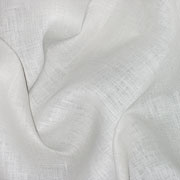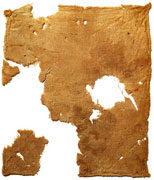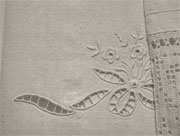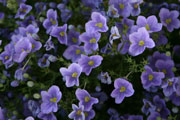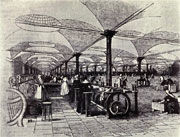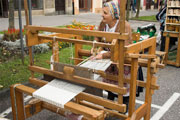Why Linen, of course! Not the bed, bath and kitchen textiles one often uses that term for, but the fabric. Made from the fibers of the Flax plant, Linum Usitatissimum, which just happens to be one of the first plants domesticated by humans (yarns, seeds and various fabrics at least 10,000 years old have been found) and used for its fibers to make cloth. Did you know it is also one of the strongest, most durable plant fiber fabrics? Pharaoh Ramses II 3200+ year old linen wrappings were in a perfect state of preservation.
Only the wealthy could afford it in ancient times, now Dharma Trading Company is selling it at unbelievably low prices! Why? So you will give it a try of course. Most folks are unfamiliar with linen, don't think they can afford it, or are just hesitant to try something different. Think of your beautiful art quilt being found 3,000 years from now!
Why is linen generally a more expensive fabric? Because the plant (Flax) needs more nurturing, and producing the relatively long fibers to make into yarn and weave is a more difficult process than something like cotton. It also makes a much finer cloth than hemp, which was cultivated in ancient times for fabric as well, but probably gave folks rug burn. It has very thin individual fibers that are longer than other plant fibers, so the yarn made with it is strong even when very fine. It is 2-3 times as strong as cotton, soft, lustrous and flexible.
Flax plants destined for linen making are normally pulled up by the roots rather than being cut down, to maximize the length of the fibers. The linen fibers are loosened from the stalk of the flax plant with a process called "retting", where it is soaked in tanks, pools or right in the field in water full of bacteria that basically rots it until it is slimy, breaking down the pectin holding the fibers together. Next, the "scutching", where the now dried stocks are crushed between 2 metal rollers so that the fibers can be separated. Shorter fibers are combed away with "heckling" combs or "hackles", leaving the longest softest fibers to spin into yarn. By products of Flax are the seeds, which are extremely nutritious and a good source of omega-3 fatty acids and fiber, and linseed oil, which has been used for centuries by fine artists and craftsmen in painting and varnishing products, and was used to make Linoleum as well. The shorter fibers are used for making high quality paper, twine, and rope.
You can read all about the fascinating world wide history of linen on Wikipedia, but you can only get to know its wonderful qualities in person. Highly absorbent and much cooler and fresher in hot weather than cotton, linen is a good heat conductor, therefore feels cool to the touch. It quickly wicks moisture away from the skin. Because of the long fibers, it is very smooth, with a lovely natural luster, and is relatively lint free. It is an excellent fabric for surface design! Linen is initially crisp, but gets softer every time you wash it. It has moderate shrinkage, can withstand high temperatures, and resists dirt, stains, moths and carpet beetles! The strong fibers do not stretch out of shape and resist abrasion damage. Linen is often mixed with other fibers like cotton and rayon, both to bring the price down, and also to have a softer initial fabric, with the linen greatly enhancing the qualities of the other fibers.
Linen is used for garments that are superior hot weather wear, and also, traditionally, for finer more expensive tablecloths, napkins, handkerchiefs, bed sheets, and the like. France originated the term "lingerie" for lightweight undergarments like chemises, shirts, and detachable collars and cuffs made exclusively from linen. Early 20th century, no gentleman would be caught without his carefully pressed and folded linen hankie! It is used for curtains and upholstery, even expensive wallpaper. Professional oil painters prefer it as their canvas. In short, it is a durable multipurpose archival fabric limited only by your imagination!










